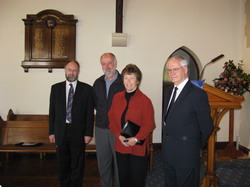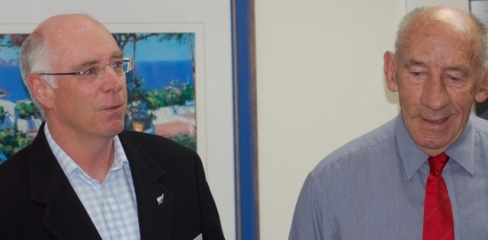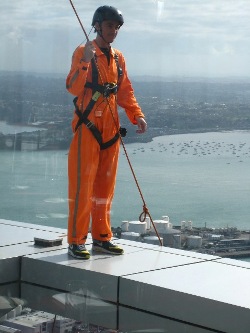Roger and Daphne came to New Zealand from Britain in 1962.
Dorothy – 03/09/04
Their primary reason for migrating to New Zealand was that Roger had been appointed as a lecturer to the new Chemical Engineering Department at the University of Canterbury. Migration at that time was easy and common. Daphne had been contemplating coming here before she met Roger, while he had cousins in the North Island. Roger’s aunt had married a New Zealander. His family had kept up a correspondence with her and with another New Zealander, who had been a prisoner during World War II. This meant that although 13,000 miles was a long way to go to a new home they felt they knew quite a lot about their destination before they left.
The message from Roger’s aunt was: “Food is cheap, but manufactured goods are scarce and expensive.” The result was that they brought out all their household goods and furniture.
They remember being surprised that the power lines were not all underground and that some streets were paved only in the middle – a fact which would impress Roger as he rode a bicycle to go to work. He also explored the Port Hills on his bike and rode along the Summit Road. What a contrast it was with the hills today with many cars, walkers and people on mountain bikes. When Roger rode there in 1962 there were few cars, fewer walkers and seldom anyone else on a bike. The other surprise was the brownness of the hills and the plains – a great contrast with the green landscape in England.
The School of Engineering was in a new building on the University’s Ilam site, having recently moved from the centre of the city. Chemical Engineering was a new discipline. In 1962 the student intake had just doubled to twenty four students. The young department had only basic equipment and only one technician. It was a place under development and Roger looked forward to helping the place to grow. He worked there full-time until his retirement, but is still involved with chemical engineering research in the Department.
Daphne recalls that her life patterns had to change. When she did the household shopping many of the products were different and were sold in larger quantities than were usual in England. Christina was four months old when they arrived. Daphne felt anxious when the Plunket nurse who was advising on baby care gave instructions which were quite at variance with those of the nurse in England.
The houses looked quite different from houses in England. There corrugated iron was used for bomb shelters and cheap buildings, but here it was the standard roofing material for most houses. In England roofs were made of clay tiles, slate or stone split into shingles. Instead of the English terrace and semi-detached houses very close together, in New Zealand most houses were built on a separate section of about a quarter of an acre. In Britain once an area had been opened up there would be buildings going up quickly over all the plots, whereas here one house might stand alone in a new subdivision for some time before the others were built.
Building a house, they found, was more difficult than it had been in Britain. They were shocked to find that they were expected to have one third of the cost as a deposit, whereas in the UK they had needed only one tenth for their cheaper English house. They discovered that they had to be careful to check a land agent’s story to be sure that the properties in any subdivision had the sewer laid on and connected, because the building of the sewers had not kept up with the spread of the city after the war.
Roger made friends among his colleagues at the University, but Daphne was confined mainly to the house with a young baby. They joined a city church attended by many immigrants and met people there. They had to walk to church, pushing Christina’s pram, as there was no public transport on a Sunday which would get them to the service on time. It was a time-consuming trip, but friends would usually bring the young couple and their baby back home. They made good and lasting friendships in the congregation. It helped them to become settled in a new land.
Soon after their arrival Daphne joined the club for staff wives at the University. It was a good support group for wives who were newcomers to Christchurch. The Club ran a baby-sitting service which banked “sits” with “repayment” in kind, enabling couples with children to go out in the evenings. For Daphne and Roger, with no other family members living in Christchurch, these arrangements enabled them to socialise and to go to the cinema occasionally. Daphne became an enthusiastic member of the Staff Wives Club until it disbanded in later years as society changed. One offshoot of that Club remains – the Newcomers Group, helping spouses to settle happily in Christchurch and befriending visitors to the University. Daphne is still involved in that.
Related Articles
- A 1952 immigrant’s view – “I can live happily in many places, but New Zealand has a lot going for it”
- Newly married Dutch engineer and English school teacher chose immigration to New Zealand
- Recent migrants comment on living in Christchurch, New Zealand – the advantages and the disadvantages




